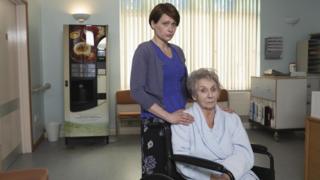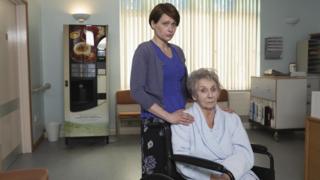Stafford Hospital scandal: The real story behind Channel 4’s The Cure
A new drama tells the story of the Stafford Hospital scandal – one of the biggest in the NHS’s history. …

 Image copyright CHANNEL4/LAURA RADFORD
Image copyright CHANNEL4/LAURA RADFORD It was one of the biggest scandals in the history of the NHS and saw hundreds of patients die. Now the story of Stafford Hospital, told through the eyes of campaigner Julie Bailey, is being brought to screens in new Channel 4 drama The Cure. BBC News takes a look at the Stafford Hospital scandal.
What happened at Stafford Hospital?
The failings at Stafford Hospital are considered one of the biggest scandals in the history of the NHS, with years of abuse and neglect at the hospital leading to the unnecessary deaths of hundreds of patients.
In 2009, a report by the Healthcare Commission laid bare the problems at Stafford, which was run by the Mid Staffordshire NHS Trust.
The regulator condemned “appalling” standards of care and reported there had been at least 400 more deaths than expected between 2005 and 2008.
It listed a catalogue of failings, including receptionists assessing patients arriving at A&E, a shortage of nurses and senior doctors, and pressure on staff to meet targets.
Later, an independent inquiry chaired by Sir Robert Francis QC, with a report published in February 2010, stated that hospital patients had been left “sobbing and humiliated” by uncaring staff.
It said the trust had become driven by targets and cost-cutting and said the distress and suffering had been “unimaginable”.
When a public inquiry – also chaired by Sir Robert – opened in November 2010, it was the fifth inquiry into the higher than expected deaths at the hospital.
The inquiry sat for more than a year between 2010 and 2011, taking evidence from more than 160 witnesses over 139 days and with more than a million pages of evidence submitted.
It heard accounts of almost unimaginable neglect – with patients left in soiled sheets, others crying out in pain and some so dehydrated they drank from flower vases.
What was the outcome of the inquiry?
In his report, published in February 2013, Sir Robert found there were failings from the top to the bottom of the NHS.
At the time he said: “This is a story of appalling and unnecessary suffering of hundreds of people.
“They were failed by a system which ignored the warning signs and put corporate self-interest and cost control ahead of patients and their safety.”
He said the public’s trust in the NHS had been “betrayed” and a change of culture was needed to “make sure that patients come first”.
Sir Robert made 290 recommendations, saying “fundamental change” was needed to prevent the public losing confidence.
Responding in the House of Commons, then-Prime Minister David Cameron apologised to the families of patients.
In 2014, Health Secretary Jeremy Hunt backed calls to close down Mid Staffordshire NHS Foundation Trust. The trust ceased to provide services on 2 November 2014 and has been formally dissolved.
Stafford and Cannock hospitals have continued to operate but are now run by different providers.
Who is Julie Bailey?
NHS campaigner Julie Bailey helped expose the failings at Stafford Hospital. She set up the Cure the NHS group after the death in 2007 of her mother Bella, who had been admitted to the hospital for a hernia operation.
The cafe she used to run in the town became the group’s headquarters but her campaigning led to her receiving online abuse and she was forced to move away from Stafford because of safety fears.
The Cure will tell the story of the scandal through the eyes of Ms Bailey, who became a CBE in March 2014 in recognition for services to the care of older people.
She told BBC Breakfast making the drama had been “a wonderful experience, although hard”.
And while she said there had been “huge improvements in the NHS since”, she feared it was “still as difficult to speak out, inside and outside the system”.
What do other bereaved families think of the drama?
Some campaigners who lost relatives in the scandal say they are angry the drama has been made without their consent.
Among them is Katie Basford who lost her grandfather while she was still at school.
She said she faced insults and attacks from people throughout her school and college career, including accusations she and fellow campaigners wanted to close the hospital.
“To have it turned into a drama for entertainment, I feel betrayed,” she said.
“I shouldn’t have had to go through that from the age of 11, I shouldn’t be reliving it at 23 and seeing my family having to go through it.”
Deb Hazeldine, whose mother Ellen Linstead died at the hospital in December 2006, said she was “stunned and speechless” when she found out the drama was being made.
She said she had been accused of “trying to make money out of my dead mum”, and was concerned current services at the hospital could be adversely affected by a scathing portrayal of the past.
Channel 4 said it decided from the outset the film was to be based on Julie Bailey’s personal experience.
The broadcaster said it appreciated the drama featured a sensitive subject, but had handled it with “the utmost care and respect”.
A statement said: “Anyone who did not want to be involved has not been referred to or depicted.”
What happened following the scandal?
In November 2014, a new NHS trust – University Hospitals of North Midlands (UHNM) Trust – was set up. It took over Stafford Hospital, which was renamed County Hospital, and also operated a second hospital in Stoke-on-Trent.
The trust incorporated the activities of the former University Hospital of North Staffordshire NHS Trust (UHNS) and most of the activities of the former Mid Staffordshire NHS Foundation Trust (MSFT), while some of the services provided by MSFT were transferred to the Royal Wolverhampton NHS Trust.
Tracy Bullock, chief executive of UHNM, said: “The whole NHS was shocked and saddened by the severe failures in care at Mid Staffordshire Hospitals, between 2005 and 2009.”
She said the publication of Sir Robert’s inquiry report in 2013 “led to a change of culture, including a tougher inspection regime by the CQC (Care Quality Commission) and a duty of candour to patients and their families”.
“Whilst it is important that those lessons are learned and what happened is never forgotten, it is equally important to recognise that Mid Staffordshire NHS Foundation Trust no longer exists,” Ms Bullock said.
“The County Hospital is a much valued and highly regarded local hospital.
“During the last five years there has been significant investment in improving facilities and services, including the refurbishment of all wards, a new chemotherapy centre and installation of new laminar flow theatres at County Hospital.
“I am very proud of our loyal and dedicated staff who work hard to maintain the highest standards.”
The Cure airs on Channel 4 at 21:00 GMT on Thursday 19 December

